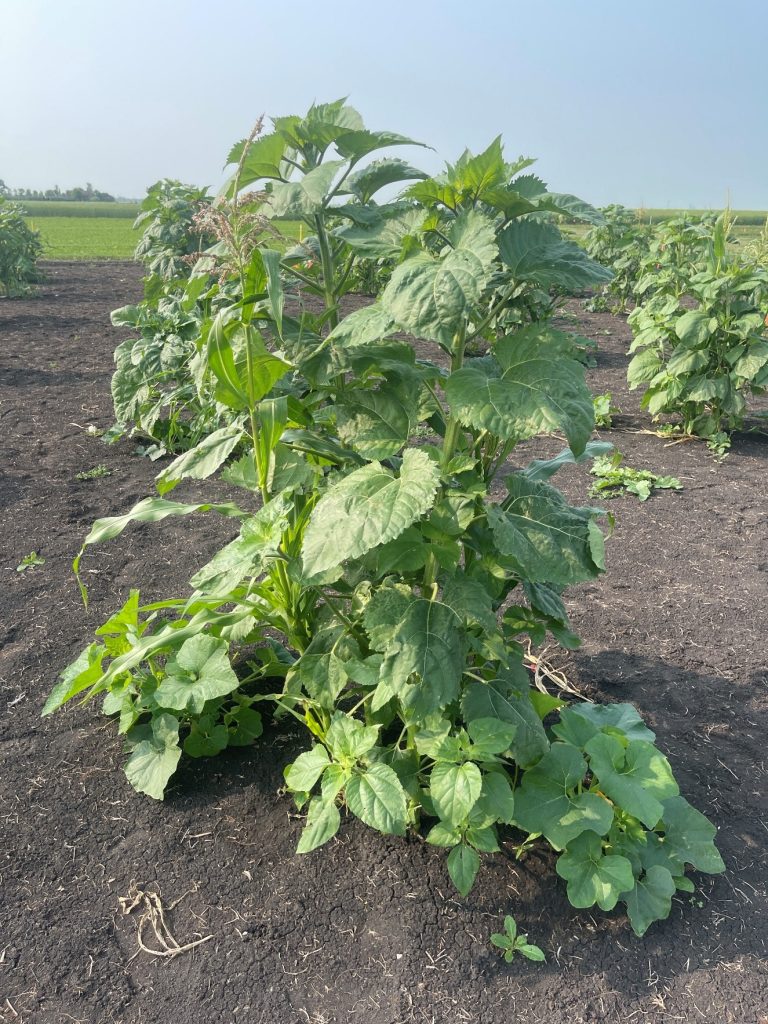By: Leia Weaver, North Eastern Ontario Regional Communication Coordinator
A collaboration between Dr. Kyle Bobiwash of the University of Manitoba and the University of Guelph is looking to understand entomological data surrounding the Indigenous agricultural practice of the “Three Sisters”. Supervised by Dr. Bobiwash, master’s student Victoria Smelko is undertaking her second year of gathering and evaluating the insect population attracted to the plots. This Indigenous practice of companion planting beans, squash and corn has been well documented but less formally researched in an agricultural academic setting. There are known benefits to and from each plant, from nitrogen fixing by the beans, structure from the corn for the beans to grow up, and shade from the squash, as the crops grow and mature together. The crops nurture each other as they grow, just as sisters, hence the name. Traditional varieties including Assiniboine flint corn and blue pole bean were used, and sunflowers were added for this trial to increase the peak bloom period.

Along with his role at University of Manitoba, Kyle is also a researcher in residence at the Office of the Chief Science Advisor of Canada. This appointment is part of a federal initiative to have an interdepartmental Indigenous science, technology, education and math (STEM) cluster committed to departmental capacity building, bridging knowledge systems, and creating inclusive strategies and programs. Dr. Bobiwash is most interested in understanding environment and species habitat connections by looking at it through the eyes of organisms, which, in this case, are insects.
This research is a collaborative effort and a great example of creating linkages between institutions. Each month, the team participates in a call to discuss the Three Sisters project. This includes OMAFRA, University of Manitoba, University of Guelph (with sites hosted at Emo and New Liskeard) and Collège Boréal, which has a site near Sudbury. Two trials are also occurring in Manitoba, including one long-term project at Brokenhead Ojibway First Nation.
At the research stations, to target a greater plant population, some changes were made to increase establishment of crops from 2022. In 2023, corn and sunflower were planted together on mounds in May, and squash was started indoors, to be transplanted. Beans were seeded later in June. More plants were established in a new pattern on small mounds, using two of each crop variety.
A selection of traps and counts are being used for the data collection, including targeted aerial netting, pitfall traps for beetles and bee bowls at the canopies for fliers. With the assistance of Dr. Bobiwash, Dr. Josh Nasielski of University of Guelph and Elaine Roddy from OMAFRA, the raw entomological data will be reviewed over the winter of 2023-2024. So far, Smelko has visually observed a noticeably larger diversity in the beneficial insect presence within the three sisters plots as compared to the natural areas adjacent to the trial.
Roddy highlighted how her own work has been invigorated by this project, using it as a stepping stone to become involved in similar projects and learn new ways to look at both plants, and the agricultural industry.
The project is an example of not how research currently is, but the way it could be. “Through the ups and downs we’re learning how to better create that proper ethical space that will allow future questions by community to be driven by their priorities, ways of knowing and being, and their values”, says Smelko. This can help build community interest and capacity in local food systems through supportive practices that honour other ways of being and contributing. Projects such as these can also help the expansion of traditional seed supply to support the endeavors of different communities of producers.

Another research project has been ongoing through Agriculture and Agri-Food Canada (AAFC) in Ontario and Quebec to study the benefits of certain intercropping practices, building on the Three Sisters Principles. The researchers were able to document other beneficial intercropping companions, like canola and peas, oats and peas, mustard and lentils, chickpea with flax, as well as hazelnut and berry bushes. These plants can assist each other when grown together simultaneously in the field. The AAFC group will also contribute by sampling and evaluating the nutritive data of the corn, squash and beans from Smelko’s trials when grown, and even eaten together.
Viewing our world as a habitat from the perspective of those that live here can bring new questions and ways of knowing, versus a top-down, industry-centered approach. When a community is confronted by an ivory tower of knowledge seekers operating at a high level of academia for research, this can feel intimidating and some of the best brains may self-select out, as they do not see opportunity for allyship.
If there is a teachable moment to be found from this collaborative project, perhaps it is to learn to be a better listener as we approach research, with a focus on what happens when it comes to the choice between industry versus nature and why diversity of both plants and people is a strength to be fostered going forward.